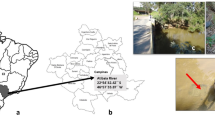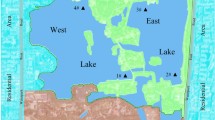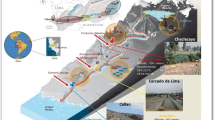Abstract
Ciliated protozoa are important components of the microbial food web in various habitats, especially aquatic environments. These organisms are useful bioindicators for both environmental quality assessment and the wastewater purification process. The pathogenic parasitic protozoan species Giardia and Cryptosporidium represent a significant concern for human health, being responsible for numerous disease outbreaks worldwide. The predation of cysts and oocysts in 15 ciliate species from water and sewage samples collected in Campinas, São Paulo, Brazil were verified under laboratory conditions. The ciliated protozoan species were selected based on their mode of nutrition, and only bacterivorous and suspension-feeders were considered for the experiments. The species Blepharisma sinuosum, Euplotes aediculatus, Sterkiella cavicola, Oxytricha granulifera, Vorticella infusionum, Spirostomum minus, and Stentor coeruleus ingested cysts and oocysts, the resistance forms of Giardia spp. and Cryptosporidium spp., respectively. This is the first time that the ingestion of Giardia cysts by ciliated protozoa has been reported. These findings may contribute to a better understanding of the biological removal of these pathogens from aquatic environments.

Similar content being viewed by others
References
Bagatini IL, Spínola ALG, Peres BM, Mansano AS, Rodrigues MAA, Batalha MA, Lucca JV, Godinho MJL, Tundisi TM, Seleghim MHR (2013) Protozooplâncton e suas relações com as condições ambientais em 13 corpos d’água da bacia do Rio Mogi-Guaçu – SP, Brasil. Biota Neotrop 13:152–163 (In Portuguese)
Baldursson S, Karanis P (2011) Waterborne transmission of protozoan parasites: review of worldwide outbreaks—an update 2004–2010. Water Res 45:6603–6614
Berger H (1999) Monograph of the Oxytrichidae (Ciliophora, Hypotrichia). Monographiae Biologicae. Springer Science+Business Media Dordrecht. Kluwer Academic Publishers
Berger H (2006) Monograph of the Urostyloidea (Ciliophora, Hypotrichia). Monographiae Biologicae. Springer Science+Business Media Dordrecht. Kluwer Academic Publishers
Betancourt WQ, Duarte DC, Vásquez RC, Gurian PL (2014) Cryptosporidium and Giardia in tropical recreational marine waters contaminated with domestic sewage: estimation of bathing-associated disease risks. Mar Pollut Bull 85(1):268–273
Bichai F, Payment P, Barbeau B (2008) Protection of waterborne pathogens by higher organisms in drinking water: a review. Can J Microbiol 54:509–524
Bichai F, Barbeau B, Dullemont, Y, Hijnen W (2010). Role of predation by zooplankton in transport and fate of protozoan (oo)cysts in granular activated carbon filtration. Water Quality Technology Conference and Exposition, 197–209
Bonatti T R, Branco N, Felisardo G, Siqueira-Castro ICV, Franco RMB (2014) Monitoring of Giadia spp. and Cryptosporidium spp. and biodiversity of ciliated protozoa in surface water and sediment samples of the Atibaia River, Campinas, São Paulo, Brazil. In: International Congress of Parasitology, ICOPA XIII, Mexico
Boscaro V, Vannini C, Fokin SI, Verni F, Petroni G (2012) Characterization of “Candidatus Nebulobacter yamunensis” from the cytoplasm of Euplotes aediculatus (Ciliophora, Spirotrichea) and emended description of the family Francisellaceae. Syst Appl Microbiol 35:432–440
Brookes JD, Antenucci J, Hipsey M, Burch MD, Ashbolt NJ, Ferguson C (2004) Fate and transport of pathogens in lakes and reservoirs. Environ Int 30(5):741–759
Cantusio Neto R, Santos LU, Franco RM (2006) Evaluation of activated sludge treatment and the efficiency of the disinfection of Giardia species cysts and Cryptosporidium oocysts by UV at a sludge treatment plant in Campinas, south-east Brazil. Water Sci Technol 54:89–94
Cantusio Neto R, Santos LU, Sato MIZ, Franco RMB (2010) Cryptosporidium spp. and Giardia spp. in surface water supply of Campinas, Southeast Brazil. Water Sci Technol 62:217–222
Díez B, Pedrós-Alió C, Massana R (2001) Study of genetic diversity of eukaryotic picoplankton in different oceanic regions by small-subunit rRNA gene cloning and sequencing. Appl Environ Microbiol 67:2932–2941
Dopheide A, Lear G, Stott R, Lewis G (2009) Relative diversity and community structure of ciliates in stream biofilms according to molecular and microscopy methods. Appl Environ Microbiol 75:5261–5272
Dopheide A, Lear G, Stott R, Lewis G (2011) Preferential feeding by the Ciliates Chilodonella and Tetrahymena spp. and effects of these protozoa on bacterial biofilm structure and composition. Appl Environ Microbiol 4564–4572
Fayer R, Trout JM, Walsh E, Cole R (2000) Rotifers ingest oocysts of Cryptosporidium parvum. J Eukaryot Microbiol 47(2):161–163
Fenchel T (1980) Suspension feeding ciliated protozoa: feeding rates and their ecological significance. Microb Ecol 6:13–25
Finlay BJ, Fenchel T (1996) Ecology: role of ciliates in the natural environment. In: Hausmann K, Bradbury PC (eds) Ciliates: cells as organisms. Gustav Fischer Verlag, Stuttgart, pp 417–440
Foissner W (1992) Estimating the species richness of soil protozoa using the “non-flooded petri dish method”. In: Lee JJ, Soldo AT (eds) Protocols in protozoology. Allen Press, Lawrence, pp B10.1–B10.2
Foissner W, Berger H (1996) A user friendly guide to ciliates (Protozoa, Ciliophora) commonly used by hydrobiologists as bioindicators in rivers, lakes and waste water, with notes in their ecology. Freshw Biol 35:375–482
Foissner W, Blatterer H, Berger H and Kohmann F (1991) Taxonomische und ökologische Revision der Ciliaten des Saprobiensystems – Band I: Cyrtophorida, Oligotrichida, Hypotrichia, Colpodea. Informationsberichte des Bayer. Landesamtes für Wasserwirtschaft, 1/91, 478p
Foissner W, Berger H and Kohmann F (1992) Taxonomische und ökologische Revision der Ciliaten des Saprobiensystems – Band II: Peritrichia, Heterotrichida, Odontostomatida. Informationsberichte des Bayer. Landesamtes für Wasserwirtschaft, 5/92, 502p
Franco RMB, Rocha-Eberhardt R, Cantusio Neto R (2001) Occurrence of Cryptosporidium oocysts and Giardia cysts in raw water from the Atibaia River, Campinas, Brazil. Rev Inst Med Trop Sao Paulo 43:109–111
Greinert-Goulart JA (2013) Estudo da remoção de cistos de Giardia spp. e oocistos de Cryptosporidium spp. e caracterização da microfauna em estações de tratamento de esgoto: instrumentos de avaliação e controle do processo. Thesis of Doctorate, University of Campinas
Hausmann K (2002) Food acquisition, food ingestion and food digestion by protists. Jpn J Protozool 35:85–95
Huamanchay O, Genzlinger L, Iglesias M, Ortega YR (2004) Ingestion of Cryptosporidium oocysts by Caenorhabditis elegans. J Parasitol 90(5):1176–1178
Hunter PR, Thompson RCA (2005) The zoonotic transmission of Giardia and Cryptosporidium. Int J Parasitol 35:1181–1190
King BJ, Monis PT, Keegan AR, Harvey K, Saint C (2007) Investigation of the survival of Cryptosporidium in environmental waters. Cooperative Research Centre for Water Quality and Treatment, Salisbury
Kotloff KL, Blackwelde WC, Nasrin D, Nataro JP et al (2012) The Global Enteric Multicenter Study (GEMS) of diarrheal disease in infants and young children in developing countries: epidemiologic and clinical methods of the case/control study. Clin Infect Dis 55:S232–S245
Lynn D (2008) The ciliate protozoa. Characterization, classification and guide to the literature, 3rd edn. Pergamon Press, New York
Lynn DH, Small EB (2002) Phylum Ciliophora. In: LEE JJ, Bradbury PC, Leedale GF (eds) An illustrated guide to the protozoa. Society of Protozoologists, Lawrence, pp 371–656
Méndez-Hermida F, Gómez-Couso H, Ares-Mazás E (2007) Possible involvement of Artemia as live diet in the transmission of cryptosporidiosis in cultured fish. Parasitol Res 101(3):823–827
Monis P, King B, Keegan A (2014) Removal and inactivation of Cryptosporidium from water. In: Cacciò SM, Widmer G (eds) Cryptosporidium: parasite and disease. Springer-Verlag, Wien
Montagnes DJS, Barbosa AB, Boenigk J, Davidson K, Jürgens K, Macek MF, Parry JD, Roberts EC, Šimek K (2008) Selective feeding behaviour of key free-living protists: avenues for continued study. Aquat Microb Ecol 53:83–98
Nawrot D, Mieczan T (2012) Co-occurrence of psammonic ciliates and rotifers in poor eutrophic lake (Łęczna-Włodawa Lakeland). Teka Kom Ochr Kszt Środ Przyr – OL PAN 9:125–133
Nawrot D, Mieczan T (2014) Ciliates vs. another components of microbial loop in the psammolittoral zone: horizontal distribution. Turk J Zool 38:168–178
Radek R, Hausmann K (1996) Phagotrophy of ciliates. In: Hausmann K, Bradbury PC (eds) Ciliates: cells as organisms. Gustav Fischer, Stuttgart, pp 197–219
SANASA (Sociedade de Abastecimento de Água e Saneamento). Available in <http://www.sanasa.com.br/noticias/not_con3.asp?par_nrod=567&flag=TA> Access in October 2015
Sato MIZ, Galvani AT, Padula JA, Nardocci AC, Lauretto MS, Razzolini MTP, Hachich EM (2013) Assessing the infection risk of Giardia and Cryptosporidium in public drinking water delivered by surface water systems in Sao Paulo State. Braz Sci Total Environ 442:389–396
Sherr E, Sherr BF (2002) Significance of predation by protists in aquatic microbial food webs. Antonie Van Leeuwenhoek 81:293–308
Sigee DC (2005) Grazing activities in the freshwater environment: the role protozoa and invertebrates. Chapter 9. In: Freshwater microbiology: biodiversity and dynamic interactions of microorganisms in the aquatic environment, pp 401–441
Stott R, May E, Matsushita E, Warren A (2001) Protozoan predation as a mechanism for the removal of Cryptosporidium oocysts from wastewaters in constructed wetlands. Water Sci Technol 44:191–198
Stott R, May E, Ramirez E, Warren A (2003) Predation of Cryptosporidium oocysts by protozoa and rotifers: implications for water quality and public health. Water Sci Technol 47:77–83
Strom SL, Loukos H (1998) Selective feeding by protozoa: model and experimental behaviors and their consequences for population stability. J Plankton Res 20:831–846
Swaffer BA, Vial HM, King BJ, Daly R, Frizenschaf J, Monis PT (2014) Investigating source water Cryptosporidium concentration, species and infectivity rates during rainfall-runoff in a multi-use catchment. Water Res 67:310–320
Vaerewijck MJM, Sabbe K, Baré J et al (2011) Occurrence and diversity of free-living protozoa on butterhead lettuce. Int J Food Microbiol 147(2):105–111
Verity PG (1991) Feeding in planktonic protozoans: evidence for non-random acquisition of prey. J Eukaryot Microbiol 38(1):69–76
Wilks SA, Sleigh MA (1998) Grazing rates in Euplotes mutabilis: relationship between particle size and concentration. Microb Ecol 36:165–174
Yamashiro S, Foco M, Silva G A, Bonatti TR, Nour EAA, Siqueira-Castro ICV, Franco RMB (2014) Removal of Giardia spp. cysts and Cryptosporidium spp. oocysts and characterization of microfauna from a treatment system employing anaerobic filter followed by Biofilter Submerged Aerated applied to sanitary sewage receiving hospital effluent. In: Congresso da Sociedade Paulista de Parasitologia, São Carlos
Zhou K, Xu M, Liu B, Cao H (2008) Characteristics of microfauna and their relationships with the performance of an activated sludge plant in China. J Environ Sci 20:482–486
Acknowledgments
We would like to thank the São Paulo Research Foundation (process numbers 2010/16222-4 and 2011/502448) and the National Council for the Improvement of Higher Education (CAPES) for supporting this work.
Author information
Authors and Affiliations
Corresponding author
Additional information
Responsible editor: Philippe Garrigues
Rights and permissions
About this article
Cite this article
Siqueira-Castro, I.C.V., Greinert-Goulart, J.A., Bonatti, T.R. et al. First report of predation of Giardia sp. cysts by ciliated protozoa and confirmation of predation of Cryptosporidium spp. oocysts by ciliate species. Environ Sci Pollut Res 23, 11357–11362 (2016). https://doi.org/10.1007/s11356-016-6689-y
Received:
Accepted:
Published:
Issue Date:
DOI: https://doi.org/10.1007/s11356-016-6689-y




